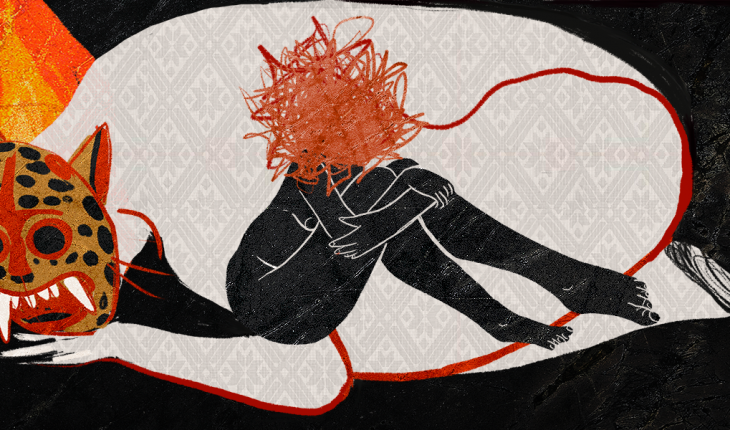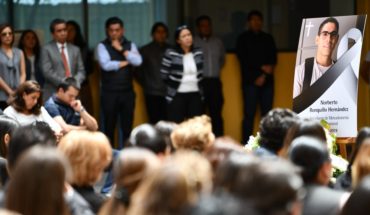Violet has never had anxiety disorder or panic attacks before. At the age of 29, stable work in a communication company and an independent life, the world seemed to spin without further a problem. Then came the COVID-19 pandemic.
On Saturday, June 13, 2020, she began with what were clear symptoms of the disease for her. She was tired, her head and body hurt. Then it started with a cough. He called Locatel. They wrote it down as a suspect case. They told him to stay home and follow up. They didn’t contact her again until 15 days later.
Alone in her department and without the guidance of any health personnel, Violeta, whom we will call to reserve her identity at her request, began to distress. Twice he felt he couldn’t breathe. He called a medical friend. She asked him to describe what he felt when he couldn’t pull air. The young woman described to her that she felt severe tightness in her chest.
“He told me that if the shortness of air were for COVID, I would feel a pain in my back, which rather indicated that I was having panic attacks.”
Read: Mexicans distrust public health services, prefer private ones even though they can’t afford them
“The coVID-19 global pandemic and changes in social dynamics as a result of it have had significant impacts on people’s lives, which go beyond the direct consequences of spreading the virus, and include economic, social and emotional challenges,” the results of the *Access to Health and Rule of Law Survey under COVID-19 World Justice Project.
According to this survey, 27%, of the more than 2,000 respondents across the country, ensured that COVID-19 quarantine security measures had caused them some stress-related illness. Nearly 3 out of 10 people reported this impact on their lives and health.
Silvia Morales Chaine, coordinator of Training and Psychological Services Centers of the Faculty of Psychology of UNAM, says that, in the strategy they launched together with the National Institute of Psychiatry of the Ministry of Health to provide mental health telephone care to the general population, they have provided, in six months, 2,567 specialized services for cases of violence , depression and risk of self-harm or suicide.
“For us at UNAM, that’s a record of attention. We’ve never been in so much demand before,” says Morales Chaine.
Violet had not been taken into account, but she had been exposing hem a lot to the news of the pandemic and economic crisis, and had done so locked up in her apartment. He ended up afraid of spreading and dying.
When her friend told her she had panic attacks, she tried to calm down but by then she lived glued to the oximeter with which every hour she measured her blood oxygen level, which sometimes used to drop to 89 in panic.
“Three or four times a day I felt like I was suffocating, especially in the mornings. The feeling was so strong that I needed to pull my head out the window and pull air.”
The young woman could no longer go out to the corner shop for the most indispensable food without being terrified and was also terrified of contact with people.
“I was afraid they’d take my food, I felt like I was going to get it, I’d take it with gloves and disinfect everything. One day I ran out of internet and I didn’t want to call the company because I didn’t want a technician sent. I was paralyzed for about an hour in front of the phone and I just called because if I couldn’t work,” she says.
Juan José Sánchez Sosa, professor emeritus and former director of the Faculty of Psychology of UNAM, says that both the health sector and this study house have documented that there are certain psychological affectations derived from the pandemic that are generating suffering.
Among the most common is anxiety, “this kind of floating fear that in this case is not so floating because we know well that this fear is coVID”, explains Sánchez Sosa.
There are also depressive symptoms, such as a deep sadness that can’t be removed with anything and that prevents you from enjoying things. “We started to stop doing things we did, we started to stop enjoying them, we neglect our appearance and what we’re doing, we start eating too much or we stop eating, we sleep too much.”
Read: Unemployment, less income, debt: this is how COVID affected the pocket of Mexicans
In addition there may be anger, family violence, irritability, intolerance, a permanent state of alertness, hyperactivity, problems concentrating.
Psychiatrist Gady Zabick Sirot, current head of the National Commission against Addiction (Conadic), explains that all these anxiety or attack conditionspanic can lead to other physical ones.
“An anxious clinical picture, along with a depressive clinical picture, is a condition that can affect many physiological functions, such as appetite, sleep, and people lose weight, their immunity is decreased and this is having repercussions.”
Stress cocktail
According to the results of WJP’s telephone survey, women are most affected. Of the men who responded, 25.7% said that COVID-19 quarantine security measures had caused them some stress-related illness and 73.6 who had not. While of women, 28% said yes and 71.1% said no.
Violet didn’t understand what was wrong with her. “It was incomprehensible to me how I could dawn in tears, how I could sleep little, how I no longer ate, how I could be so afraid. I was young, healthy, independent and suddenly felt that I was no longer functional, that with this background I would no longer succeed. I was sitting around trying to eat and I was crying.”
Sánchez Sosa explains that in the face of the pandemic, the population is in a situation that combines forms of stress that almost never occur together. It’s a hard cocktail to cope with.
In Mexico, the WJP explains, some of the most common impacts of the pandemic include loss of income or work, as well as stress-related illnesses.
Stress is nothing more than the tension created by internal or external change that threatens our organized existence and requires immediate adaptation.
The WJP notes in the essay “The Twin Crises of Public Health and the Rule of Law”, that just as societies require a strong rule of law to respond to the pandemic, the norms of good governance and their ability to comply with them deteriorate.
One of the challenges revealed by the pandemic, in addition to the public health crisis, explains the WJP are barriers to access to the public health system, as well as challenges in coverage, and fair, impartial and timely treatment in clinics.
In this health crisis the chronic stress of modern and accelerated life are added episodes of acute stress, for example, to know positive, perceive symptoms, listen to the news, be afraid for the family, for the death of a close person. “And what we have then is complicated stress, a mixture of chronic and acute,” explains the doctor in psychology and human development.
By age, according to the WJP survey, the largest affectation is in the 46 to 60 age group, in which 28.7% said they do have a stress-derived condition and 70.6% who do not.
While the age group of 18 to 25 years 24.9% said it does have a stress affectation of the pandemic and 74.7 that does not.
Martha Elena Echeverría, 59, already a pensioner, says she felt enormous distress. “My mouth was dry, I thought I was getting diabetic and drinking more water. One day I started to feel bad and went to my bedroom. I felt like I was short of air, suffocating. I thought I was going to have a heart attack. I called my brother who’s a pediatrician and he said, that’s anxiety.”
She had never suffered from her, so she did not know what she was like and had not related that several things were affecting her: locking up, listening to the news, the talks of her medical brother, the concern for her mother, already very old, and her grandson, still very young and, above all, the fact that her daughter could not stop going to work and had to walk on public transport.
“My daughter works in a financial sector company, which they didn’t stop. And in the evenings, every time I gave the time when I knew I was already going to take public transport, it gave me a lot of anguish.”
Martha got to the point where she couldn’t even get out into the yard. “I felt that even inside the house I wasn’t safe, that the bug was getting in. I had a vacuum in my stomach, but I couldn’t eat because I felt like I hadn’t disinfected the food well and the bug was there.”
Zabick Sirot explains that pandemic living conditions can make people who have not previously had an anxiety disorder or panic attacks debut with them, as in the case of Martha and Violet.
“Everyone, but mainly those of us who live in big cities are very exposed to stressors, now we have also seen a lot of life habits change, and some people needed this drop that spilled the glass, so that a situation they had managed to contain would completely overflow.”
The new stressors, zabicky Sirot points out, also condition that those who already had a previous mental health problem can be sharpened.
That happened to Monserrat Muñoz, 31. In April 2019, he began having panic attacks just one year after his brother’s murder.
“I looked for a therapist and she told me it was sadness accumulatesGives. With the therapies I had already improved. Before COVID he no longer had panic attacks, in March he no longer had. I started having them again in June. I endured well the first months of confinement: March, April and May. It filled me with activities to be busy. But in June I started again with panic attacks, especially on weekends, in the mornings.”
One of the difficult parts of Confinement for Monserrat is caring for her five-year-old daughter, keeping her entertained, and helping her in her school classes; while continuing his work, he takes care of household work and deals with health restrictions.
“It’s hard because I work in a publishing house and although I’ve been able to work remotely, I have video calls frequently in the morning, when she has her classes and if she’s following them alone she’s very distracted. And when she has nothing to do she gets very bored, she wants me to play with her, but I have to work and she thinks I don’t want to play. Besides, there’s the part that they wouldn’t let her into the super, now they’re leaving her, but I had to see who was in charge so she wouldn’t leave her alone. It’s been hard,” Monserrat says.
How to combat these disorders
First you have to understand that it is normal to feel fear or anxiety in a health crisis like the current one. Both Sánchez Sosa and Zabicky Sirot agree that there are techniques that can help control these sensations, such as diaphragmatic breathing, meditation and yoga.
You also have to start doing things you don’t usually have time for, such as reading, learning a language, talking to relatives we want and friends, trying to help someone.
Most importantly, you have to take care of yourself and find a way to adapt, the UNAM specialist recommends.
“There are people who are increasing the risk perception of the possibility of infection, but we already know how this virus spreads and how to reduce the chances of infection, if we use water covers, if we wash our hands, if we are not too close to people, if we do that we should have the basic peace of mind that we are doing what is necessary not to get infected.”
Moreover, he says, “we must get used to the most likely that it is in our interest to adopt these strategies for a long time and we need to adapt. We don’t have to think that there’s no way to communicate or share with those we want because we can’t be a metre away, because then we’re going to feel bad but it’s an overreaction.”
If these strategies do not work and fear and anguish not only do not yield but cause suffering and begin to provoke behaviors and reactions that interfere with life and routine then professional help must be sought.
In Violet’s case, she first went to a psychologist, who also referred her to a psychiatrist. “In my case, he says, I’m going to be on drug treatment for a year, but I’m much better now, I’m already starting to get my life back.”
Montserrat is in consultation with the therapist who treated her since before the relapse and has been improving little by little. Martha was treated only once by phone by a private psychologist who recommended a family member, told her to make a want and that she would be fine.
Martha has sought on her own strategies to relax and deal with anguish and panic attacks. But he’s considering finding another option.
The specialists consulted stress that no one should deal with this alone, which is not at all a matter of wanting it when it is already a disorder. And it’s not about self-eating or substance use either.
In the WJP survey, 5.8% of respondents said they had increased their alcohol or drug use.
Zabicky Sirot says that unfortunately some of the people who were being treated for addictions are declining. In the Youth Integration Centers there is a 30% increase in the number of relapse care.
Instead, fear of a factor that complicates COVID tables has made 45% more people ask for first-time attention to quit smoking. There is no exact data on alcohol consumption yet, but the commissioner fears that it has increased and so has the consumption of sleep and anxiety drugs, which is under no circumstances recommended without medical supervision.
*Learn about the results of the World Justice Project’s “Access to Health and Rule of Law Survey under THE World Justice Project COVID-19: National telephone survey applied to 2352 people over the age of 18 in Mexico. Made between 4 July and 16 August 2020”.
What we do at Animal Politics requires professional journalists, teamwork, dialogue with readers and something very important: independence. You can helpto follow us. Be part of the team.
Subscribe to Animal Politics, receive benefits and support free journalism.#YoSoyAnimal





